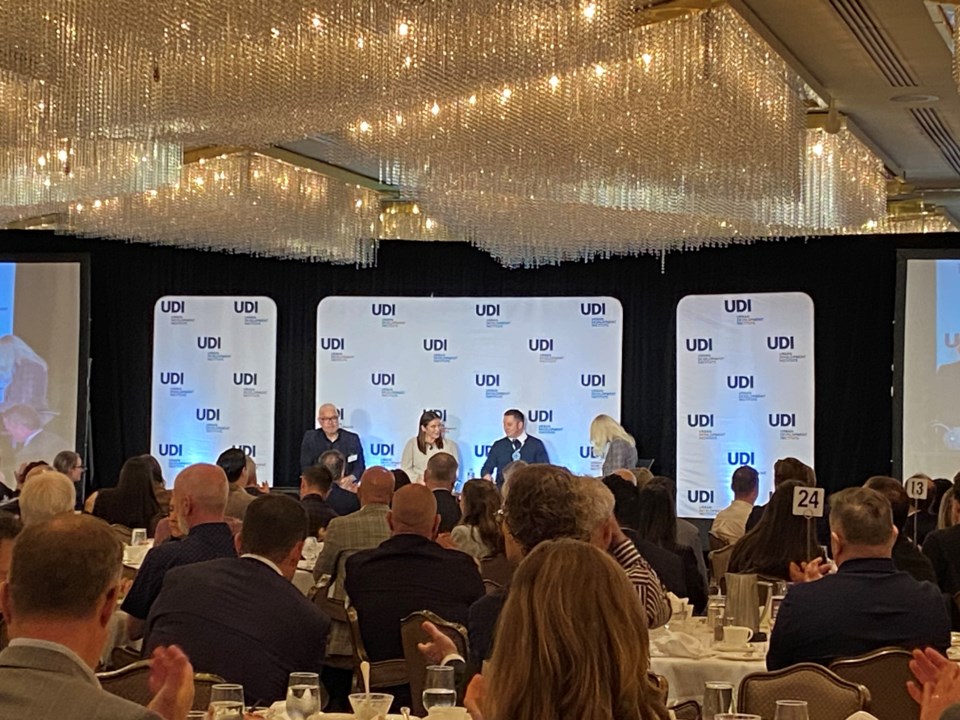A recent panel of First Nations developers highlighted the significant horizon of their real estate projects and their goal to optimize relationships with business partners who share the same vision, values and priorities.
During a Thursday luncheon at Pan Pacific Vancouver Hotel hosted by the Urban Development Institute, three First Nations leaders said they are taking great care to build long-term alignments on their path toward economic reconciliation and economic sovereignty.
The leaders said their nations’ presence dates back thousands of years, so they are in no hurry and will patiently cultivate close partnerships and leverage them to support current and future generations of their communities.
“As far as our plight, our journey, it’s been a 9,000-year journey,” said Stephen Lee, CEO of Musqueam Capital Corp. “Really just through the dispossession of lands and all the other trials and tribulations, getting to this place is really an organic thing. It’s getting back to the rightful place in terms of how we control our own destiny as well as from a business sense.”
Lee said First Nations land is sacred and scarce. He said forging relationships with the right industry allies “at the speed of trust” can help Indigenous leaders better serve their youth, elders, businesses, cultural revival and natural environments.
“We want to leverage the expertise, we want to leverage the skills of our partners so in turn we can do this ourselves,” Lee said. “So that timeline … is going to take a little while but as long as we’re aligned with the right partners, that journey is going to be smooth. It’s going to give us confidence that we’re on the right track. It’s not like we’ll cut it off at some point and say, ‘Every project is going to be 100-per-cent owned by Musqueam.’ I think just depending on the project and the partner and the strength of the alignment, those will continue.”
Lee elaborated: “It really is like any other relationship. How do you foster that and how do you nurture that? Eventually the alignments will be there, or not. We’ve got a long time. The nations will be here for a long time, so I encourage a lot of you to take that lens.”
Tsleil-Waututh Nation councillor Curtis Thomas said potential business partners should already be educating themselves on regional Indigenous history and culture long in advance. Mutual respect is key.
“All you developers, the land you’re currently developing on used to be Indigenous lands. … There’s no reason why you can’t go back to every single development you're working on right now and understand whose traditional territory it’s on and start to dig deeper and understand who those people are, the challenges they face, their community needs, and start to build this long-term meaningful relationship in a good way built on trust and transparency and not come to us with a transaction or business opportunity. Do the work, start it now. Some of you guys are already doing it. Great! Let’s tell your colleagues about the good work you’re doing, let's celebrate it. … We’re stronger when we stand together.”
Mindy Wight of Nch’kay Development Corp. agreed that ideal allies are those who prepare proactively for future collaboration. “We want … experienced partners who have the same alignment and vision and values as we do, and part of that is ensuring that you’re getting yourselves ready to have a partnership with us,” she said.
Wight continued: “It means embedding an inclusive culture within your corporation from the board level down, to ensure that you’ve got Indigenous people working for you, you’ve got policies in place, processes to ensure an inclusive work environment. Because when you come to the table for a partnership, these are the types of questions that my team will be asking alongside your experience, your financials, the normal due diligence, but on top of that is your perspective on Indigenous inclusion and priority workforce participation.”
The First Nations developers said mutual projects should facilitate grassroots participation by Indigenous youth and businesses through internships, bursaries, career mentorship, industry exposure, procurement opportunities and other forms of involvement. This can help the nations build internal capacity and enhance the capabilities of their future generations.
“We are relatively new entrants to the development community,” Wight said. “Partnership to us is something that we value very deeply. We want to ensure we work with those who reflect the same values that we embody, and part of that is actually ensuring that while we’re using their capacity and knowledge and expertise … we’re building ours internally as well. We’ve created mentorship opportunities with our partners … so that we’re building the capacity of our future generations. But even for ourselves, we’re a very small, lean team. … We know that we need to rely on partners to get it done. … ‘One plus one equals three.’”
It may take considerable time for these ambitious goals and close partnerships to be achieved, the panellists said, but their philosophy reflects that slow and steady wins the race.
“I didn’t know what long-term was until I joined Musqueam,” said Lee. “I thought long-term was five years. Long-term planning is like thousands of years, so it’s way more forgiving because once you have that horizon, you’re able to make some confident decisions.”


